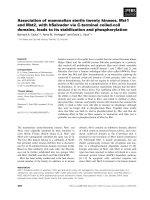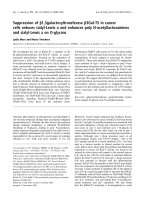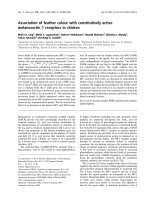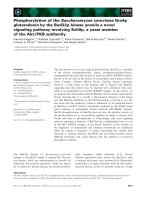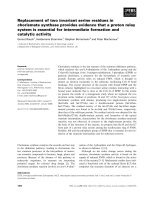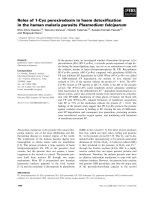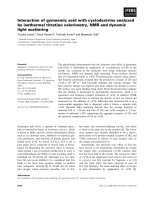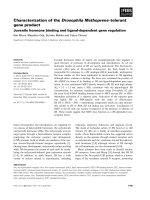báo cáo khoa học: " Association of intervention outcomes with practice capacity for change: Subgroup analysis from a group randomized trial" potx
Bạn đang xem bản rút gọn của tài liệu. Xem và tải ngay bản đầy đủ của tài liệu tại đây (254.79 KB, 6 trang )
BioMed Central
Page 1 of 6
(page number not for citation purposes)
Implementation Science
Open Access
Short report
Association of intervention outcomes with practice capacity for
change: Subgroup analysis from a group randomized trial
David Litaker*
1,2
, Mary Ruhe
3
, Sharon Weyer
3,4
and Kurt C Stange
3,5
Address:
1
Department of Medicine, Louis Stokes Cleveland VA Medical Center, Cleveland, Ohio, USA,
2
Mannheim Institute for Public Health,
Social and Preventive Medicine, University of Heidelberg, Germany,
3
Department of Family Medicine, Research Division, Case Western Reserve
University, Cleveland, Ohio, USA,
4
Frances Payne Bolton School of Nursing, Case Western Reserve University, Cleveland, Ohio, USA and
5
Department of Sociology, Case Western Reserve University, Cleveland, Ohio, USA
Email: David Litaker* - ; Mary Ruhe - ; Sharon Weyer - ;
Kurt C Stange -
* Corresponding author
Abstract
Background: The relationship between health care practices' capacity for change and the results
and sustainability of interventions to improve health care delivery is unclear.
Methods: In the setting of an intervention to increase preventive service delivery (PSD), we
assessed practice capacity for change by rating motivation to change and instrumental ability to
change on a one to four scale. After combining these ratings into a single score, random effects
models tested its association with change in PSD rates from baseline to immediately after
intervention completion and 12 months later.
Results: Our measure of practices' capacity for change varied widely at baseline (range 2–8; mean
4.8 ± 1.6). Practices with greater capacity for change delivered preventive services to eligible
patients at higher rates after completion of the intervention (2.7% per unit increase in the combined
effort score, p < 0.001). This relationship persisted for 12 months after the intervention ended
(3.1%, p < 0.001).
Conclusion: Greater capacity for change is associated with a higher probability that a practice will
attain and sustain desired outcomes. Future work to refine measures of this practice characteristic
may be useful in planning and implementing interventions that result in sustained, evidence-based
improvements in health care delivery.
Background
Systematic reviews and meta-analyses demonstrate that
many interventions to improve health care quality yield
inconsistent results when evaluated through clinical trials
[1,2]. One potential explanation for this is that the design
of standardized interventions tends to overlook contex-
tual factors that influence the implementation of new pro-
cedures in real world settings [3-8]. Exploring these factors
further and testing their association with changes in
health care delivery may therefore provide insights that
foster more rapid uptake of evidence-based care into rou-
tine use.
Over the past two decades, work conducted in a broad
range of settings has provided several ways to conceptual-
ize influences on the implementation process [7,9-13].
Published: 16 May 2008
Implementation Science 2008, 3:25 doi:10.1186/1748-5908-3-25
Received: 30 March 2007
Accepted: 16 May 2008
This article is available from: />© 2008 Litaker et al; licensee BioMed Central Ltd.
This is an Open Access article distributed under the terms of the Creative Commons Attribution License ( />),
which permits unrestricted use, distribution, and reproduction in any medium, provided the original work is properly cited.
Implementation Science 2008, 3:25 />Page 2 of 6
(page number not for citation purposes)
One descriptive framework focusing on primary care prac-
tices' ability to adopt and implement new approaches to
health care delivery[14] may be particularly valuable,
given that these practices represent a venue through which
a majority of Americans receive ambulatory care [15-18].
This framework, developed by Cohen et al., highlights the
potential role of several practice characteristics: the indi-
vidual and aggregate motivations of practice members;
the resources that they identify within and outside the
practice that are both accessible and important in support-
ing change efforts (including previous experience in using
new tools or adopting new procedures); the external
forces or factors that shape or influence change options;
and practice members' perception of options and oppor-
tunities for change.
Two factors – motivations and resources for change – are
central components of several frameworks for implemen-
tation[9,12,13], in addition to the one described by
Cohen et al. While some have suggested that practice
motivation or inertia may be important to clinical guide-
line implementations[19], motivation appears to be nec-
essary but not sufficient for change to occur [9]. That is,
confidence to act and an ability to implement change
must also be present [9,12]. Other work lends support to
this view: interventions that provide instrumental assist-
ance during the implementation phase can be effective in
fostering change once motivation exists or is developed
[20]. Thus, it is important that studies examining the asso-
ciation of practice capacity for change with implementa-
tion use measures that represent both components and
assess their potential interaction.
Despite considerable effort to characterize organizational
capacity for change at the conceptual level, only a handful
of studies have developed operational measures for this
construct and established an association with implemen-
tation outcomes. Of these, the majority focus on intention
to act rather than actual behaviors. To assess the associa-
tion of capacity for change with demonstrable improve-
ments in evidence-based health care delivery, we used
data from the Study to Enhance Prevention by Under-
standing Practices (STEP-UP). This paper tests the hypoth-
eses that greater practice capacity for change would be
associated with greater change in the STEP-UP study out-
come, preventive service delivery (PSD), from baseline to
the end of the active intervention period and that these
improvements would be sustained during follow up,
when no intervention was being offered.
Methods
The design, methods, and findings from STEP-UP have
been described in detail previously [21,22]. In brief, this
group randomized clinical trial to improve preventive
service delivery randomly assigned 79 community-based
primary care practices in northeast Ohio to a control or
intervention group. Intervention practices were assessed
by a research nurse facilitator over 1–3 days to gain an
understanding of practice roles and routine procedures.
The intervention, incorporating information from this
assessment, involved creation of a practice-individualized
plan for change using a menu of tools (e.g., chart stickers,
flow sheets, reminder cards) and approaches (e.g., person-
nel roles, delivery of preventive care during illness visits)
to enhance preventive health care. The study outcome,
delivery of preventive services recommended by the U.S.
Preventive Services Task Force[23], was determined
through review of a cross-sectional sample of medical
records for patients seen on a randomly selected day
within two weeks of study baseline (month 0), month 6,
month 12 (end of the intervention), and at follow up vis-
its at months 18 and 24. PSD rates were calculated at each
of these time points at each practice for each category of
recommended services (e.g., screening, immunizations,
and behavioral counseling). These three rates were then
combined into a single global rate of PSD for each time
point [24]. Thirty-nine practices were randomly assigned
to the intervention; the 37 practices participating in fol-
low up for the full 24 months represent the sample for this
study.
Nearly all previous studies assessing organizational capac-
ity use a quantitative approach that relies upon partici-
pant surveys [9,25-30]. While reflective of the experience
or perspectives of those working in the practice, this
approach is often limited by low response rates and may
miss practice features that are not directly assessed by the
items administered. To capture more fully the practice
characteristics representing the conceptual domains of
motivations and resources, we used a qualitative strategy
based on direct observation of the practice by research
team members. This process followed several steps. First,
each member of the team (comprised of two nurse prac-
tice change facilitators, three research nurses involved in
on-site medical record review, the epidemiologist data
analyst and the physician/epidemiologist principal inves-
tigator) read extensive ethnographic field notes generated
by the facilitator and research nurses from an assessment
used to develop the practice-individualized intervention
[20,31]. Each team member individually rated two aspects
of the practice: the amount of effort needed to motivate
practice staff to undertake the intervention (an inverse
measure of the practice's a priori internal motivation to
change), and the amount of instrumental assistance a
practice needed to implement tools and approaches
designed to increase PSD (an inverse measure of the prac-
tice's innate ability to change). Both ratings were
expressed using a four-point scale. To facilitate model
interpretation, scoring was reversed such that a value of
one represented a practice in which substantial efforts
Implementation Science 2008, 3:25 />Page 3 of 6
(page number not for citation purposes)
were required to motivate the practice or to assist them in
performing the instrumental tasks of the intervention
(i.e., low intrinsic motivation or low ability to change); a
value of four reflected the need for very little effort in
either motivating the practice or in assisting it (i.e., high
intrinsic motivation or high ability to change). The
research team then met and shared their individual rat-
ings. Discrepancies were resolved by discussing the prac-
tice from the diverse points of view of the team members.
When necessary, original data were consulted to identify
confirming or contradictory evidence for disparate rat-
ings. As a final step, numeric ratings were added to form a
single score representing the combined effort needed to
motivate or to assist each practice in implementing the
intervention.
To provide a preliminary test of the relationship between
absolute change in PSD and the capacity for change score,
we compared mean PSD values for practices in the highest
and lowest tertiles of our score using Student's t-test. We
then assessed this association more thoroughly using data
from all study outcome assessments made every six
months to develop models that accounted for repeated
measures made at each practice. Separate models were
developed to assess the association between the com-
bined practice capacity for change score and change in the
practice rate of PSD from baseline to month 12 and from
baseline to month 24. A post-hoc analysis assessed the
association of an interaction term (the product of both
ratings) with the outcome at both time points. A two-
tailed p value < 0.05 served as the threshold for statistical
significance. SPSS version 13 and HLM version 6.03 were
used to perform the analyses. The University Hospitals of
Cleveland Institutional Review Board approved this
study, which was conducted in accordance with the Dec-
laration of Helsinki principles.
Results
For the group as a whole, change in PSD from baseline to
completion of the intervention period (month 12) varied
significantly with absolute change ranging from -1% to
21% (mean 7.6% ± 5.5); at month 24, absolute change in
PSD rates ranged from -9% to 26% (mean 6.9% ± 7.0).
Regarding practices' capacity for change, the full range of
scores (0–8) was used, with average score falling in the
mid-range (mean 4.8 ± 1.6).
We observed comparable rates of PSD improvement in
the first 12 months for practices with both high and low
capacity for change scores (Figure 1), with little difference
in rates adjusted for baseline PSD. After month 12, how-
ever, significantly higher PSD rates were noted in the
group of ten practices with the highest capacity for change.
This finding was sustained through month 24, compared
with the ten practices having lowest capacity for change
(mean difference 6.2% ± 2.0; p = 0.009).
Using multiple assessments of outcomes at each interven-
tion practice, random effects models demonstrated a
2.7% increment in PSD rates at month 12 (completion of
the active intervention) for each unit increase in the prac-
tice capacity for change score (p < 0.001). This finding was
similar at month 24 (3.1%; p < 0.001). To explore differ-
ences in PSD rates related to the components of the com-
bined score, a supplemental analysis demonstrated a
strong association with instrumental change capacity
(3.2%, p = 0.002); a weaker association with motivation
to change approached significance (2.1%, p = 0.09). A sig-
nificant interaction was also observed: each one-point
increase in the product of the two ratings (indicative of
decreasing research team effort to motivate and to assist in
instrumental tasks) was associated with an increase from
baseline in PSD rates of 1.1% and 1.3% at months 12 and
24, respectively (both p values < 0.001).
Short title: Rates of Preventive Service Delivery at Practices with High and Low Capacity for ChangeFigure 1
Short title: Rates of Preventive Service Delivery at
Practices with High and Low Capacity for Change.
Service delivery rates during and after an intervention to
improve preventive care at a subset of practices estimated to
have the highest and lowest capacity for change. Each box
and bracket represent the mean and standard deviation,
respectively, for PSD rates at assessments conducted every
six months with mean difference in PSD rate adjusted for
baseline presented at bottom. The ten practices with the
highest capacity for change are indicated by the dashed line;
the ten practices with lowest capacity for change are repre-
sented by the solid line. Note: PSD = preventive service
delivery; *p < 0.01
Implementation Science 2008, 3:25 />Page 4 of 6
(page number not for citation purposes)
Discussion
These results yield two insights with potential value for
implementation research. First, using qualitative esti-
mates generated by our research team, we observe signifi-
cant variation among practices in the level of effort
required to motivate practices to undertake change and to
assist them in implementing tools and approaches to
enhance preventive service delivery. We also demonstrate
that variation in our estimates of practices' capacity for
change correlates with differences in outcomes both at the
end of an intervention and for at least 12 months thereaf-
ter. Taken together, these findings suggest that these sim-
ple measures of capacity for change have utility in
predicting intervention adoption, implementation, and
maintenance and that variation in capacity for change
may potentially explain inconsistent results of efficacious
practice-based interventions applied outside controlled
trial settings [5].
It is not surprising that variation exists in practices' capac-
ity for change. Previous work, for example, highlights the
rich differences that characterize the health system for pri-
mary care and the many factors that contribute to its evo-
lution in individual practice settings [10,31-34]. Staff with
particular skills, interests, and personal motivations, for
example, enter and leave practices regularly, while new
challenges within the larger health care system and in
society continually emerge and dissipate [33]. Acknowl-
edging these differences across practices may be useful for
implementing efficacious interventions into real world
practice settings in a variety of ways. In some cases,
researchers seeking to enhance their success in improving
health care delivery have begun to perform initial practice
assessments and to use insights from this process to guide
the development of tailored interventions [20,31,34-36].
An assessment of practice capacity for change may also be
useful in promoting greater efficiency or equity in the
deployment of an intervention, depending on the goals of
the research team. Practice assessments, for example, may
allow for the targeting of limited resources to practices
with the greatest capacity for change. If resources are less
limited, it may be possible to reduce practice-level dispar-
ities in performance by targeting greatest efforts toward
those with the lowest capacity.
Given the nature of this analysis, we cannot establish a
causal link between practice capacity for change and
implementation outcomes. Our findings, however, pro-
vide justification for future replication studies as well as
those that develop and test interventions to enhance both
motivational and instrumental change capacity. Rationale
for future developmental work in this area is further sup-
ported by evidence of a post hoc association between pre-
ventive service delivery and an interaction between these
two factors sustained over time. Recent studies in com-
mercial business settings now inform our understanding
of ways in which motivation to change might be
enhanced and new work patterns might be more readily
adopted and implemented [37-40]. One strategy, for
example, emphasizes organizational self-reflection to first
identify and later leverage existing strengths (e.g.,
resources, personal motivations, and relationships) to
build motivation within the group to undertake a project
with shared meaning. In contrast to traditional quality
improvement efforts, participants begin with a positive
focus of what might be, rather than one that seeks to elim-
inate problems or to reduce gaps. Although its effective-
ness in health care settings is currently under
investigation, a recent report describes efforts to apply the
self-reflective or appreciative approach to improve health
care delivery in primary care [41]. Caution is advisable,
however, in undertaking efforts to assess and modify
motivations and abilities within a practice for the sake of
greater implementation effectiveness, especially because
the contribution of these features relative to that of other
factors included in various conceptual models of organi-
zational capacity for change is unclear. Previous compar-
ative case studies of practices in STEP-UP show the
possibility for surprises and missed opportunities, for
example. Some practices undertake little change despite
appearing to be highly motivated and capable of change,
while others make large changes despite low capacity [20].
Our results should be interpreted within the context of
several limitations. In the absence of a control group, we
cannot exclude the possibility, for example, that unmeas-
ured practice-level factors may have confounded the asso-
ciations observed. Also, the sample of family medicine
practices used may not have been representative of this
diverse primary care specialty or of other primary care spe-
cialists (e.g., general internists, pediatricians) located else-
where. Finally, we acknowledge that the qualitative
estimates we used may have failed to capture important
dimensions of practice capacity for change. Previous stud-
ies, for example, underscore the complexity of this con-
struct [9,12-14]. Future work that develops these
measures further is needed to enable a clearer understand-
ing of the meaning and contribution of practice capacity
for change to the adoption and routine delivery of evi-
dence-based care.
Conclusion
Greater practice capacity for change is associated with
greater success in implementing and maintaining
improvements in health care delivery. Efforts to acknowl-
edge and address this practice characteristic may lead to
greater intervention effectiveness and speed the dissemi-
nation of evidence-based care into community-based pri-
mary care settings.
Implementation Science 2008, 3:25 />Page 5 of 6
(page number not for citation purposes)
Competing interests
The authors declare that they have no competing interests.
Authors' contributions
DL, MR and KS conceived of the study and participated in
its design and coordination. All authors participated in
the drafting of the manuscript and read and approved it in
its final form.
Acknowledgements
This work was supported by grants from the National Cancer Institute
(2R01 CA80862, 4R01 CA80862 & R25T-CA111898), the American Acad-
emy of Family Physicians for the Center for Research in Family Practice and
Primary Care, and the VA Health Services Research and Development
Service (IIR 06-091). The authors are grateful to practice members partici-
pating in STEP-UP, whose enthusiasm inspired this manuscript. The views
expressed in this article are those of the authors and do not necessarily
represent the views of the Department of Veterans Affairs.
References
1. Stone EG, Morton SC, Hulscher ME, Maglione MA, Roth EA, Grim-
shaw JM, Mittman BS, Rubenstein LV, Rubenstein LZ, Shekelle PG:
Interventions that increase use of adult immunization and
cancer screening services: A meta-analysis. Annals of Internal
Medicine 2002, 136:641-651.
2. Davis D, Thomson M A, Oxman A D, B. H: Changing Physician
Performance. JAMA 1995, 274:700-705.
3. Dobrow MJ, Goel V, Lemieuz-Charles L, Black NA: The impact of
context on evidence utilization: A framework for expert
groups developing health policy recommendations. Soc Sci
Med 2006, 63:1811-1824.
4. Fixsen DL, Naoom SF, Blase KA, Friedman RM, Wallace F: Imple-
mentation Research: A synthesis of the literature. In The
National Implementation Research Network Edited by: University of
South Florida LPFMHI. Tampa, FL ; 2005:1-125.
5. Glasgow RE, Lichtenstein E, Marcus AC: Why don't we see more
translation of health promotion research to practice?
Rethinking the efficacy-to-effectiveness transition. Am J Publ
Health 2003, 93(8):1261-1267.
6. McCormack B, Kitson A, Harvey G, Rycroft-Malone J, Titchen A,
Seers K: Getting evidence into practice: The meaning of 'con-
text'. J Adv Nurs 2002, 38:94-104.
7. Rycroft-Malone J, Kitson A, Harvey G, McCormack B, Seers K,
Titchen A, Estabrooks C: Ingredients for change: Revisiting a
conceptual framework. Qual Saf Health Care 2002, 11:174-180.
8. Stetler CB, Ritchie J, Rycroft-Malone J, Schultz A, Charns M: Improv-
ing quality of care through routine, successful implementa-
tion of evidence-based practice at the bedside: An
organizational case study protocol using the Pettigrew and
Whipp model of strategic change. Implementation Science 2001,
/>9. Klein KJ, Conn AB, Sorra JS: Implementing computerized tech-
nology: An organizational analysis. J Appl Psychol 2001,
86:811-824.
10. Litaker D, Tomolo A, Liberatore V, Stange KC, Aron DC: Using
complexity theory to build interventions that improve
health care delivery in Primary Care. J Gen Intern Med 2006,
21:S2:S30-34.
11. Miller WL, Crabtree BF, McDaniel R, Stange KC: Understanding
change in primary care practice using complexity theory. J
Fam Pract 1998, 46:369-376.
12. Simpson DD: A conceptual framework for transferring
research to practice. J Subst Abuse Treat 2002, 22:171-182.
13. Solberg LI: Improving medical practice: A conceptual frame-
work. Ann Fam Med 2007, 5:251-256.
14. Cohen D, McDaniel R, Crabtree BF, Ruhe MC, Weyer SM, Tallia A,
Miller WL, Goodwin MA, Nutting P, Solberg LI, Zyzanski SJ, Jaen CR,
Gilchrist V, Stange KC: A practice change model for quality
improvement in primary care practice. Journal of Healthcare
Management 2004, 49:155-169.
15. Benson V, Marano MA: Current estimates from the National
Health Interview Survey. In Vital Health Stat Volume 10(198).
Hyattsville , National Center for Health Statistics; 1994.
16. Ries P: Physician contacts by sociodemographic and health
characteristics, United States, 1982-1983. In National Center for
Health Statistics, Vital and Health Statistics 1987 Washington, DC , Gov-
ernment Printing Office; 1987.
17. Schoenborn CA, Adams FP, Schiller JS: Summary health statistics
for the U.S. population: National Health Interview Survey,
2000. In Vital Health Stat 10 Volume 10. Issue 214 National Center
for Health Statistics; 2003:1-83.
18. Cherry DK, Burt CW, Woodwell DA: National Ambulatory
Care Survey: 2001 summary. Vital and Health Statistics of the
National Center for Health Statistics 2003, 337:.
19. Cabana MD, Rand CS, Powe NR, Wu AW, Wilson MH, Abboud PAC,
Rubin HR: Why don't physicians follow clinical practice guide-
lines? A framework for improvement. Journal of the American
Medical Association 1999, 282:1458-1465.
20. Ruhe MC, Weyer SM, Stange KC, Zronek S: Facilitating practice
change: Lessons from the STEP-UP clinical trial. Am J Prev
Med 2005,
40:728-734.
21. Goodwin MA, Zyzanski SJ, Zronek S, Ruhe MC, Weyer SM, Konrad
N, Esola D, Stange KC: A clinical trial of tailored office systems
for preventive service delivery: The Study to Enhance Pre-
vention by Understanding Practice (STEP-UP). Am J Prev Med
2001, 21(1):20-28.
22. Stange KC, Goodwin MA, Zyzanski SJ, Dietrich AJ: Sustainability of
a practice-individualized preventive service delivery inter-
vention. Am J Prev Med 2003, 25:296-300.
23. Force USPST: Guide to Clinical Preventive Services: Report of
the U.S. Preventive Services Task Force, 2nd ed. 2nd edition.
Alexandria, VA , International Medical Publishers; 1996.
24. Stange KC, Flocke SA, Goodwin MA, Kelly RB, Zyzanski SJ: Direct
observation of preventive service delivery in community
family practice. Prev Med 2000, 31(2 Pt 1):167-176.
25. Courtney KO, Joe GW, Rowan-Szal GA, Simpson DD: Using organ-
izational assessment as a tool for program change. J Subst
Abuse Treat 2007, 2007:131-137.
26. Fuller BE, Rieckmann T, Nunes EV, Miller M, Arfken C, Edmundson E,
McCarty D: Organizational readiness for change and opinions
toward treatment innovations. J Subst Abuse Treat 2007,
33:183-192.
27. Lehman WE, Greener JM, Simpson DD: Assessing organization
readiness for change. J Subst Abuse Treat 2002, 22:197-209.
28. Rampazzo L, De Angeli M, Serpelloni G, Simpson DD, Flynn PM: Ital-
ian survey of Organizational Functioning and Readiness for
Change: A cross-cultural transfer of treatment assessment
strategies. Eur Addict Res 2006, 12:176-181.
29. Saldana L, Chapman JE Henggeler, SW, Rowland MD: The Organi-
zational Readiness for Change scale in adolescent programs:
Criterion validity. J Subst Abuse Treat 2007, 33:159-169.
30. Stockdale SE, Mendel P, Jones L, Arroyo W, Gilmore J: Assessing
organizational readiness and change in community interven-
tion research: Framework for participatory evaluation.
Ethn
Dis 2006, 16 (1 Suppl 1):S136-145.
31. Crabtree BF, Miller WL, Stange KC: Understanding practice
from the ground up. J Fam Pract 2001, 50(10):881-887.
32. McIlvain H, Crabtree BF, Medder J, Miller WL, McDaniel R, Stange
KC, Solberg LI: Using "practice genograms" to understand and
describe practice configurations. Fam Med 1998, 30:490-496.
33. Miller WL, McDaniel RR Jr, Crabtree BF, Stange KC: Practice jazz:
understanding variation in family practices using complexity
science. J Fam Pract 2001, 50(10):872-880.
34. Stange KC: "One size doesn't fit all." Multimethod research
yields new insights into interventions to improve preventive
service delivery in family practice. J Fam Pract 1996,
43(4):358-360.
35. Jaen CR, McIlvain H, Pol L, Phillips RL, Flocke SA, Crabtree BF: Tai-
loring tobacco counseling to the competing demands in the
clinical encounter. J Fam Pract 2001, 50:859-863.
36. Cheater F, Baker R, Hearnshaw H, Robertson N, Hicks N, Oxman A,
Flottorp S: Tailored interventions to overcome identified bar-
riers to change: effects on professional practice and health
care outcomes. In The Cochrane Library The Cochrane Collabora-
tion; 2003.
Publish with BioMed Central and every
scientist can read your work free of charge
"BioMed Central will be the most significant development for
disseminating the results of biomedical research in our lifetime."
Sir Paul Nurse, Cancer Research UK
Your research papers will be:
available free of charge to the entire biomedical community
peer reviewed and published immediately upon acceptance
cited in PubMed and archived on PubMed Central
yours — you keep the copyright
Submit your manuscript here:
/>BioMedcentral
Implementation Science 2008, 3:25 />Page 6 of 6
(page number not for citation purposes)
37. Attwood M, Pedler M, Pritchard S, Wilkinson D: Leading change:
A guide to whole systems working. Bristol, U.K. , The Policy
Press; 2003.
38. Barrett F, Fry R: Appreciative Inquiry: A Positive Approach To
Building Cooperative Capacity. Chagrin Falls, OH , Taos Insti-
tute Publications; 2005.
39. Cooperrider D, Sorensen P F Jr, Yeager T F, D. W: Appreciative
Inquiry: An Emerging Direction for Organization Develop-
ment. Champaign, IL , Stipes Publishing LLC; 2001.
40. Wensing M, Wollersheim H, R. G: Organizational interventions
to implement improvements in patient care: a well struc-
tured review of reviews. Implement Sci 2006, 1(2):.
41. Carter C, Ruhe M, Weyer SM, Litaker D, Fry R, Stange KC: An
Appreciative Inquiry Approach to Transformative Change in
Health Care Settings. Quality Management in Healthcare 2007,
16(3):194-204.
